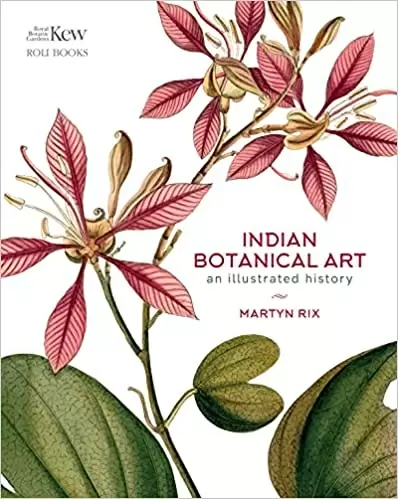India's vibrant botanical art returns home in lavishly illustrated tome
New Delhi
29-September-2021

PHOTO: IANS
Term it colonialism in reverse. A seminal book brings together the striking botanical art of Indian origin spanning a period of 300 years drawn mostly from original works held in the collections of the Royal Botanic Gardens, Kew (London), that showcase the richness and variety of art commissioned from talented, mostly unknown, Indian artists who made a substantial contribution to the documentation of the flora of the Indian subcontinent.
"The book shows how much Indian paintings were valued in Europe in the late 18th and early 19th centuries. Many people working in India in the early 19th century brought back collections of paintings; some of the most valuable are now in the museum in Exeter in Devonshire, but, sadly, their history and the names of those who commissioned them have been lost," Rix added.
As most of the original paintings shown in this book have never been published before, the book gives an idea of the different styles of painting and especially how botanical illustrations are both artistic and scientific in the portrayal of plants.
The book has its genesis in the author's deep study of the roots of botanical art.
"My interest in botanical art began a long time ago, and I made paintings of flowers as a child: this ceased when I bought a 35 mm camera and could record flowers on film. But I kept my interest in botanical illustration, and the first book I wrote was 'The Art of the Botanist' (1981) which described botanists' travels and the work of the artists associated with them," Rix explained.
This was based mainly on the books in the Royal Horticultural Society's Lindley Library in London. Some of the most beautiful of these volumes were lithographs of flowers of the Himalaya, based on paintings by Indian artists for doctors and botanists who went to India from Scotland in the early 19th century; notable amongst them were William Roxburgh's "Plants from the Coast of Coromandel, Nathaniel Wallich's "Plantae Asiaticae Rariores" and J.F. Cathcart's "Illustrations of Himalayan Plants".
Watch This TWL Video
"One of the most memorable travels of my youth was a visit to Kerala and Tamil Nadu in 1970 to study the African pile (Salvinia molesta) a floating fern which was smothering the waterways; at the same time, I saw many other exciting plants, and used Robert Wight's books to help identify them; his two artists, Rungiah and Govindoo, made hundreds of drawings from 1828 onwards which were printed, hand-coloured and published in Madras," Rix added.
As a research associate at Kew, he was able to study the original paintings for many of these publications in the library, and they form the main part of this book.
Writer-scholar-museum curator Sita Reddy notes in the foreword that due to Indian botanical artists of the 18th?and 19th?centuries remaining rather unknown, contemporary Indian artists have "inherited a hybrid botanical art tradition whose artists were invisible, then and now". To that extent, the book has actually corrected a historical wrong. How does Rix feel to be a pathfinder?
"It was unfortunate that one of the first of the Scottish doctors to publish Indian botanical paintings, William Roxburgh, did not name his artists and the paintings were not signed. Even in Europe at that time most artists were considered mere craftsmen and not valued as much as the academic botanists. (The exception to this was the French botanical artist, P.J. Redoute who started his own publishing company, made his fortune but spent it and then died in poverty.)
"Later Indian artists however were mostly given full recognition, and that has enabled some such as Visnupersaud, who worked both for Nathaniel Wallich in Kolkata, and for John Royle in Saharanpur (UP) to be recognised as one of the great botanical artists of the 19th century. Other artists from the late 18th century, such as Sheikh Zain al-Din Ram Das and Bhawani Das (originally from Patna) have been recognised recently, and their work now fetches great prices (around 15,000 pounds, and much more for birds and bats!) in London; they painted not only flowers, but birds, mammals, fish and snakes as well, working mainly in Kolkata," Rix explained.
In the book, he has tried to show how the Indian artists, trained in the Mughul tradition were able to produce works closer to the European 18th century tradition.
"From the 17th century onwards, rich Mughals possessed European illustrated books and asked their artists to copy them. Some of these copies can be seen in an album painted by the artist Mansur around 1615," Rix said.
How would he term the state of botanical art in India today?
"There is a resurgence of botanical painting in India, which is particularly valuable when it focuses on wild and rare plants and on forests and other habitats threatened with destruction by modern developments; the contrasting styles of Hemlata Pradhan and Nirupa Rao could form the beginning of a huge flowering of Indian botanical painting.
"As in the past it is necessary for botanists to encourage artists and provide them with good specimens to illustrate, so that the paintings have lasting scientific as well as artistic value," Rix said.
"I hope my book may inspire more people in India to take up botanical painting and exhibit their paintings in America or in London as have Hemlata and Nirupa. The Royal Horticultural Society in London, and the American Society of Botanical Artists and the Hunt Botanical Institute, all have regular exhibitions and welcome artists from all over the world. Indeed, some of the most highly regarded artists now exhibiting in London are based in Korea and Japan, he added.
In addition, Curtis's Botanical Magazine (of which he is now the editor), publishes articles on interesting plants, especially those newly discovered, and relies on botanists and artists to combine their talents.
"This has been the purpose of the Magazine since it began in 1787 and continues today, and it would be good to receive contributions from India," Rix concluded - IANS
More Headlines
Karti Chidambaram Meets PM Modi, Proposes National Task Force To Tackle Stray Dog Issue
7.7 Magnitude Earthquake in Myanmar Leaves 20 Dead
7.7 Magnitude Earthquake Strikes Myanmar, Tremors Felt in Thailand, India
Mamata Banerjee Says She 'Differs' With India Being Largest Economy, BJP Confronts
EPS Meets Amit Shah, Fuels AIADMK-BJP Alliance Speculation
Karti Chidambaram Meets PM Modi, Proposes National Task Force To Tackle Stray Dog Issue
7.7 Magnitude Earthquake in Myanmar Leaves 20 Dead
7.7 Magnitude Earthquake Strikes Myanmar, Tremors Felt in Thailand, India
Mamata Banerjee Says She 'Differs' With India Being Largest Economy, BJP Confronts
EPS Meets Amit Shah, Fuels AIADMK-BJP Alliance Speculation










